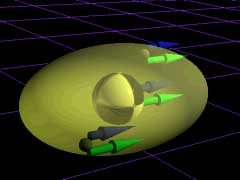| Ch 6. Rigid Body Force and Acceleration | Multimedia Engineering Dynamics | ||||||
|
Moment of Inertia |
Translational Motion | Fixed Point Rotation |
General Plane Motion |
||||
| Translational Motion | Case Intro | Theory | Case Solution | Example |
| Chapter |
| - Particle - |
| 1. General Motion |
| 2. Force & Accel. |
| 3. Energy |
| 4. Momentum |
| - Rigid Body - |
| 5. General Motion |
| 6. Force & Accel. |
| 7. Energy |
| 8. Momentum |
| 9. 3-D Motion |
| 10. Vibrations |
| Appendix |
| Basic Math |
| Units |
| Basic Dynamics Eqs |
| Sections |
| eBooks |
| Dynamics |
| Fluids |
| Math |
| Mechanics |
| Statics |
| Thermodynamics |
| ©Kurt Gramoll |
|
|
||||||||
|
Unlike previous chapters on particle motion, these chapters and sections are concerned with both the motion of a rigid body as a whole and the motion about its center of mass. When dealing with the motion of a rigid body, the actual shape of the object must be considered. However, only motion in a 2D plane will be analyzed in this chapter. |
||||||||
| Translation |
||||||||
 |
The simplest motion is translation. This is similar to linear particle motion except with rigid bodies, the object's dimensions may need to be considered. If a rigid body in motion does not rotate (will be discussed in the next section), it is said to be in translation. Every point of a rigid body in translation has the same velocity and acceleration. Thus, describing the motion of one point, such as the center of gravity, describes the entire body. For 2D motion in a plane, the object is governed by
where "cg" refers to the center of gravity. Further, since a body in translation does not rotate, This is a scalar equation since only 2D is considered in this chapter. This equation does not mean there are no moments, but simply the sum of all moments must equal zero. There is no rotational motion. |
|||||||